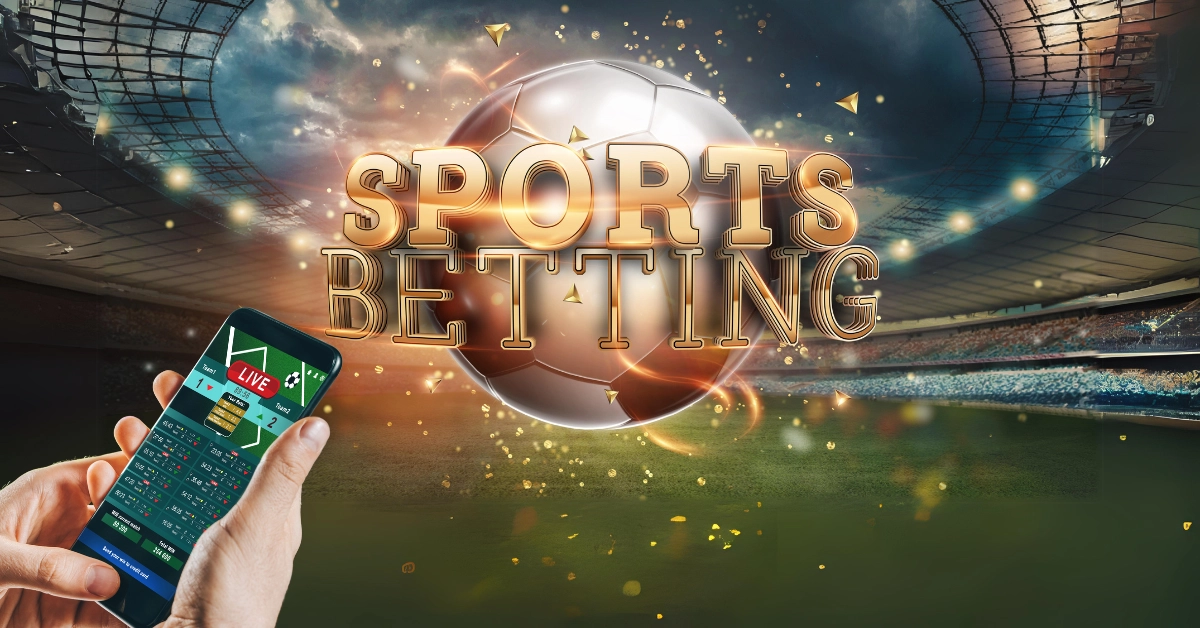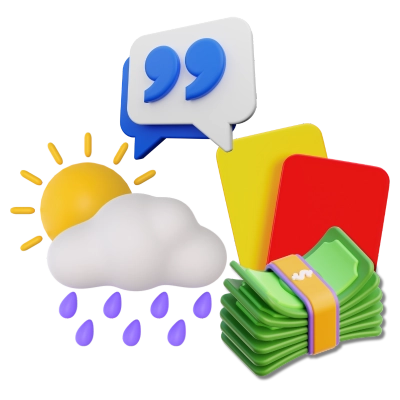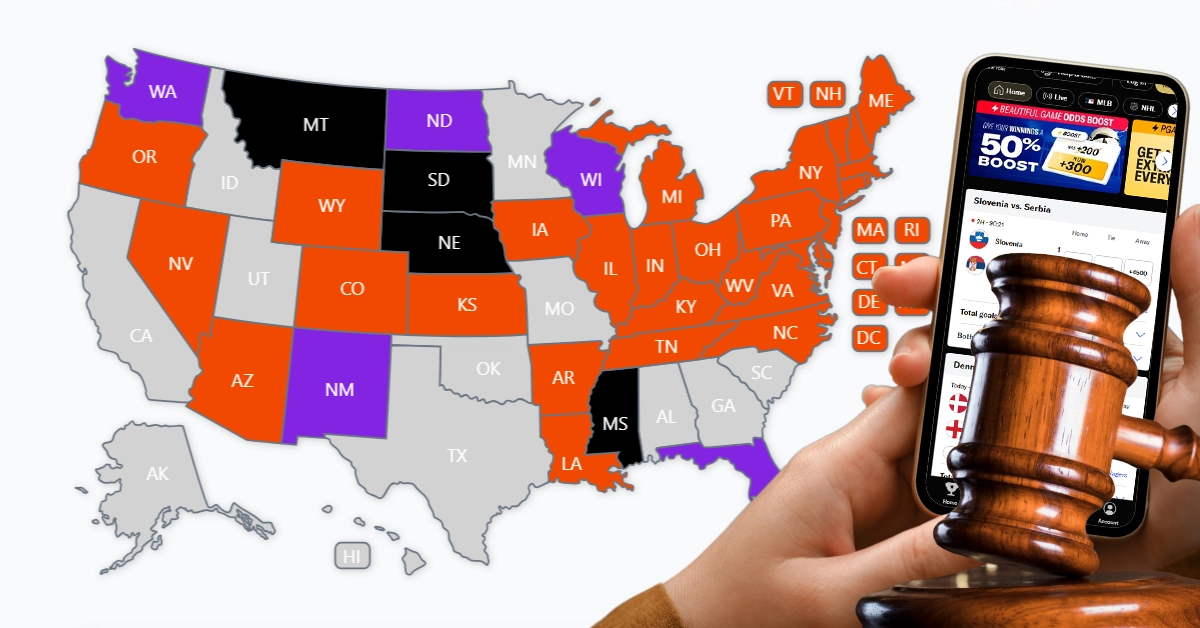The Science of Odds: How Bookmakers Determine the Betting Lines

Understanding odds in sports betting and how your favorite sports book operates are necessary to know to succeed with betting online. Understanding the likelihood of any outcome you bet on is essential. Still, it’s just as important to understand how the odds are set, why line movement occurs, and what drives fluctuation in the bookmakers’ odds.
This informative review will cover everything you need to know about odds and how they work! We’ll discuss the science of odds in our guide to give you a better understanding of how everything works on your favorite sports betting site. Keep reading to get an overview of the fundamentals of odds and the role data plays in how bookmakers set up odds at online sportsbooks. Learn about how various external factors affect how odds and lines shift.
We have a lot to cover, so let’s dive in!
Fundamentals of Odds
Let’s talk about the odds. What are the odds? Odds define the likelihood of an outcome for each side of a sports game, event, or competition. Odds can dictate betting behavior because different teams or competitors establish a favorite and an underdog. However, there are ways to place bets on the underdog where you could win modest payouts or potentially rake in a considerable payout when an upset occurs.
To get good at reading odds and finding value in the numbers, the oddsmakers put out on online betting apps; you need to become familiar with odds formats and the different straight bets that these betting sites offer. We’ll highlight these principles in more detail below.
Odds Formats
Odds can be presented in three formats: American, decimal, and fractional odds. The three formats are alternative ways of presenting the same information and have no bearing on how you get paid out on your bet.
American Odds
These odds signify the favorite to win with a negative sign (-) and the underdog with a positive sign (+). Here’s an example of how you might find American odds when you’re on your favorite sportsbook:
Bills
-500
Steelers
+700
The Bills are the favorite to win because their odds have a negative number, while the Steelers are the underdog with a positive number. Because the Bills are more likely to win, you have to bet more than you would on the Steelers, but you’re almost guaranteed to win. You must stake $500 and win $100 if the Bills win, for a total payout of $600.
If you want to go out on a limb and bet on the underdog Steelers to win, you only have to stake $100, but you’ll win $700 in profit if Pittsburgh pulls off the upset. Your total payout is $800 because you get your original $100 bet back in addition to your profit.
Decimal Odds
Decimal odds are sometimes called European odds because they are popular all over Europe and in other Western countries like Australia, New Zealand, and Canada. These odds represent the amount the bettor could win for every dollar they wager.
Here’s an example of what these odds might look like at your favorite betting app:
Bills
1.4
Steelers
3.0
1.4 is like -250 in American odds or ⅖ in fractional odds. The implied probability is 71.43%. 3.00 is like +200 in American odds. The implied probability is 33.33%.
In this instance, the Bills are favored to win over the Steelers. A bet of $100 on Buffalo would result in a profit of $40 ($100 x 1.4). The total payout would be $140 because you get your original bet back. Those who bet $100 on the Steelers to win can earn a profit of $200. The total payout is $300 if the Steelers win over the Bills because you make $200 and get your original bet of $100 back.
Fractional Odds
Fractional odds are the preferred odds format for people in the United Kingdom and Ireland. British fractional odds are the ratio of profit won to the bettor’s stake. Fractional odds are presented using backslashes (/) or hyphens (-). An example is 4-1 or (4/1) odds. You could refer to them as “four-to-one” odds. For every $1 you wager, you can win $4.
Bills
4/1
Steelers
1/2
If you find 4-1 odds on the Bills win over the Steelers and bet $20 on the Bills, you will win $80 in profit ($20 x 4) and get your original wager back. Your total payout if the Bills win $100 altogether.
Basic Sports Bets
Now that you know how to read odds in different formats, let’s talk about the basic kinds of bets and the likelihood of winning these bets. These are known as straight bets, and they only offer two outcomes, unlike exotic bets, such as parlays or props, where there are multiple outcomes. Statistically, you have a 50/50 chance of getting these bets right, though there’s still some variance in how often they
- Moneylines: These are bets where you’re trying to predict who will win the game or competition. Moneylines are the most essential sports bet, and you have a 50/50 chance of getting it right. However, you must look at the odds to determine who’s the favorite to win and who’s the underdog.
- Point Spreads: These bets are where you’re trying to predict the margin of victory correctly. As a result, there are opportunities to bet on the favorite or the underdog, and you have a decent shot of winning by betting on either side.
Let’s say the Bills are the -3 favorite to win, and the Steelers are the +3 underdog. For a bet on the Bills to win, they must win the game by over 3 points. For a bet on the Steelers to win, they must either win the game outright or lose by less than 3 points. - Totals: These are called over/under bets, and bettors try to correctly predict the total number of points scored by both teams for a game or competition. The oddsmakers will put out an estimated number of points combined they think will be scored, and the bettor will decide if the final combined score comes in over or under this number.
The Role of Data in Setting Odds
Bookmakers use data to establish the odds they assign to teams or competitors. They don’t just pull the numbers out of thin air—there’s research to back up the bookmakers’ selections.

- Team/Player Performance – One of the top factors bookmakers check when preparing their odds is looking at the past performance of the team or competitor. They examine whether the team/player is gaining momentum or losing steam. The stronger the team, the more likely they will win the next big game or competition. The stronger teams go on to be the odds-on favorite at the sportsbooks, though there are chances for upsets if there’s too much confidence placed on a favorite and they choke.
- Head-to-Head Matches – Bookmakers will use historical data from teams or players to form potential head-to-head matchups. It’s a way to pinpoint patterns or tendencies for individual players to see how a possible scenario could play out based on historical data.
- Home Court Advantage – If one of the teams is playing on their home fields, rink, or court, there’s a good chance they’ll win because they’re playing amongst their home crowd. Even if the home team is the underdog, bookmakers will adjust the odds to favor the underdog more because they are getting more support from the crowd.
- Market Fluctuation – Odds will move when bookmakers examine the number that competitors are offering. They want to be competitive, so they’ll adjust the odds if their numbers are close to other sportsbooks’.
Once these factors are considered, bookmakers will put out their final numbers for the favorite and the underdog. The odds assigned are the likelihood of either outcome occurring, and the betting lines are the midway point between each scenario.
Adjusting Odds for Market Conditions
The thing to understand about betting apps is that they are a business looking to profit. They aren’t going to put out winning lines all the time because the betting public would place all their bets on a sure thing and win a ton of money, basically bankrupting the sports betting site. That would be a terrible business design.
Instead, sportsbooks aim to have relatively even action on all sides of any given bet. Ideally, they want a balance of bets on all outcomes to avoid having to pay out a ton of money to the majority of bettors. This is why you see bets like point spreads encouraging you to bet on the underdog team where you can win your bet even if they lose. Or consider money lines that tempt bettors to wager on the underdog by offering a low bet and a bigger profit.
Leveraging Sportsbooks’ Business Model to Your Advantage
The more you can learn about how the sportsbooks operate and make a profit, the more insights you can gain on how to make well-informed betting decisions. Weirdly, you’re not just betting on sports, but you’re taking advantage of the game the sportsbook plays to earn its profit as a way to win money. Consider the habit of sharps and professional bettors to place their bets right before a game or event because they want to get the lower price on the other side of the bet. If they respect them enough, this can force sportsbooks to move the line toward the sharp bettors.
Vigorish (Juice)
“Vig” is short for vigorish. This is the fee charged by the bookmakers for accepting a gambler’s wager. Vigorish is also called juice, the cut, the tak, the margin, under-juice, or the house edge. Basically, this money guarantees the sportsbook a profit regardless of the outcome of the games or competitions they’re offering odds on.
The vigorish will change based on the odds offered to the bettor. When viewing the odds, vigorish is always there even if it’s not entirely apparent to you. We mentioned that another name for vigorish is “house edge.” This is important because vigorish is the edge of the betting app over the average bettor. If a bettor wants to be profitable long-term with sports betting, they must beat the vig consistently over time.
Examples of Vigorish
Bettors need to be aware of how vig impacts their bottom line.
Think about points spreads or totals where the odds are both sides are -110. You get two different bettors to wager on both sides. The sportsbook is collecting $110 on both sides, which is $220 altogether. A winning bet with odds of -110 guarantees a profit of $100, so whoever wins the bet gets a payout of $210 because they make $100 and get their original $110 bet back.
So, how much did the sportsbook make altogether? They collected $220 between two bettors ($110 for a bet on each side) and paid out $210, ensuring they made a profit of $10. That’s their vigorish: $10.
The Impact of External Factors
We’ve discussed these things already, but let’s delve deeper into external factors and how they can impact the outcome of your sports bets. You can look at factors like weather, player injuries or suspensions, public opinion/media influence, economic factors, regulatory changes, or legal developments to see how the odds will ultimately be influenced on your favorite sportsbook.

- Injuries or Suspensions – Bookmakers will take any player injury or suspension that might have a significant impact on the game’s outcome. For example, if an NFL team’s star player is out with an injury and cannot play, there’s a good chance the team will be the underdog for the next betting round. There’s a nuance that comes with injuries or suspensions because some players might not be as integral as others when it comes to helping the team win.
- Weather Conditions – Bookmakers will consider weather for outdoor sports like football, soccer, or golf. Some teams or players have a better track record of performing well in inclement conditions, forming the basis for bookmakers to assign favorites and underdogs.
- Economic Factors – During times of economic downturn, like the one we’re currently experiencing, people will tend to limit their discretionary spending on gambling, ultimately leading to fewer bets. This is when sportsbooks might begin introducing more competitive odds than usual to get more money circulating. When the economy is good, there’s increased participation from the betting public.
- Regulatory Changes/Legal Developments – Odds will fluctuate when new bettors are introduced into the fold by legalizing sports betting in certain jurisdictions, municipalities, territories, or states. This adds to the overall money flow that sportsbooks can take in.
- Public Opinion/Media Influence – This is a public sentiment. You’ll find out quickly who the public, media, or sports fans consider the favorite to win at the next big game. As the favorite attracts most of the public’s bets, the sportsbooks will adjust the odds to encourage more betting on the underdog, like point spreads or more enticing moneyline bets.
Not only do oddsmakers look at aspects like past player performance or head-to-head matchups to inform the odds they assign, but they also look at these external factors to develop the best possible numbers. Something like public opinion can drive many bettors to favor one side heavily, forcing the sportsbook to make the other side more favorable to balance the action.
Psychological Elements in Odds-Making
Because bookmakers are interested in turning a profit and keep doing so by maintaining betting action balanced on both sides of a bet, they tend to use psychological strategies to make sure lines more appealing to bettors. Because anything could happen during a sports game or event, this choice to balance the betting action isn’t insidious. Still, it’s the sportsbooks’ way of covering every angle to insulate themselves from losing a bunch of money and having to pay out a ton of winning bettors.

- Risk-Averse vs. Embracing Risk – Betting apps know there are two kinds of bettors—those who avoid taking risks and those willing to embrace risk to earn higher rewards. Part of the reason you have betting action on both sides isn’t just because the sportsbook is trying to balance out the wagers but because they know some want to play it safe and those who want to go out on a limb.
- Past Outcomes – When a team or player has had a strong performance streak, it’s easy for sportsbooks to convince bettors to stake money on them because building momentum is a good indicator of a favorite to win. On the flip side, betting apps can convince bettors to wager on the other team because all winning streaks have to end sometime.
- Social Influences – If you have the media or a ton of online sports fans really hyping up a particular team or player, it’s not difficult for a sportsbook to convince bettors to embrace these wagers. Hyping can lead to a lot of confidence or overconfidence on the bettor’s part.
- Emotional Attachments – Many sports bettors make the mistake of faithfully betting on their favorite team no matter what. They fail to look for value in bets on rival teams or players. However, this makes things easy for the sportsbook, which doesn’t have to worry about finding even action on either side of a moneyline. There are always plenty of fans out there to ensure things stay balanced on either side of the line.
Technology and Odds
As time passes and technology becomes more sophisticated, odds-making is being left more and more to advanced algorithms and odds-making software, which can better process data points and variables. Real people are still a major part of the odds-making process because someone has to run these systems and pick up on potential mistakes the algorithms might miss. Still, technology is being used in partnership with human insight/wisdom to enhance the online sports betting experience.

The Use of AI
No matter where you stand on the issue of AI, it’s a tool that’s becoming more common in how odds are determined and presented in online sports betting. These advanced systems have been beneficial recently in detecting and preventing fraudulent activities, irregularities in the numbers, and match-fixing.
AI is even a helpful resource for people who want to adhere to responsible gambling practices. The system will send bettors alerts when they stray from best practices. Another way in which AI is helping bettors make better picks and selections for their bet slips is by offering tailored recommendations that are aligned with the bettors’ personal approach and risk preferences.
The Bookmaker’s Edge
All sports betting sites have to make a profit to stay in business. This is why you see vig (juice) on all bets offered—it’s a cut that the sportsbook is guaranteed to keep their business running. This bookmaker’s edge” is essential for all sportsbooks to continue operating and offer their customers competitive sports betting opportunities.
Gaining an Edge Over the Bookmakers
If your main goal in sports betting is to become profitable over time, slowly adding to your overall bankroll bit by bit, you have to employ a strategy where you’re beating the vig or juice more often than not. There are several ways to set yourself up for winning your sports bets more frequently, and many of them revolve around looking for value and simply doing your research.
Start using these strategies to gain an edge over your sportsbook and wind up on the winning side of the curve more often than not:
- Bet on sports markets you know the most about. The more knowledge you have of specific teams and players, the more informed your bets will be, and this increases the likelihood of your bet winning.
- Place your bets right before the game or event. This can account for last-minute changes in the team roster, weather, or line movement when the sharps place their bets. If there’s uneven action, sportsbooks will begin offering great deals on the other side to entice bettors to place wagers on the other side of the line.
- Shop around for value. You can do this using multiple sportsbooks. If you’ve found a bet where your probability of winning is better than the odds the sports betting site offers, there’s a good chance you’ve found a high-value bet.
- Stick with bets where you have a 50/50 chance of getting it right, like money lines, totals, or point spreads. Avoid bets like parlays or props—they have multiple outcomes.
- Stay committed to a sound betting strategy. Establish your betting units—use a small percentage of your bankroll, 1-2%. Keep this the same across all bets you place, no matter how hot the bet may be.
- Keep on top of good bankroll management. Stick to your betting strategy. Uphold any budget or time limits you set for yourself. Don’t bet on sports if you’re frustrated or upset. Emotional betting can screw up your bankroll.
Challenges in Setting Odds
Oddsmakers come up against a significant obstacle when setting up odds for online sportsbooks: sharp bettors and syndicates. Sharps are professional bettors who have a great deal of skill and knowledge in sports betting. They have a significant edge over other bettors because they have well-refined methods for handicapping sports games and competitions that work in their favor. A syndicate is a group of sharp bettors who combine forces and resources to see if they can chip away even more at the house edge the sportsbook holds.
How Do Sharps and Syndicates Affect the Odds?
There are two primary scenarios where sharps will be on the other side of the line from where the general public is placing their bets:
- The sharps have information that the public at large doesn’t have access to, which shows that the underdog team is likely to win. The sharps will bet against the public because they have the research that shows the underdog has the true edge, which means an upset and a big payout are coming. As more sharps bet on the dog, the line will move away from the betting action on the favorite toward the sharps.
- The sharps want to bet on the favorite, but they don’t care for the prices, so they’ll place large bets on the underdog to drive the line toward the other side in an attempt to get a more favorable price on the odds they want.
At the end of the day, bookmakers do their best using their knowledge and technology, like odds-making algorithms, to offer the best, most accurate odds to the customer.
Lines will move authentically in the event of player injuries/suspensions, weather conditions, media influence, economic factors, or regulatory changes. Still, when the sharps and syndicates are out, they could be moving the line to get a better deal on their odd, so it’s not genuinely representing the likelihood of a specific outcome. It’s purely a strategic move that allows sharps to get the sportsbook to force a discount.
Conclusion
How bookmakers set the odds is a complex interplay of data analysis, market psychology, and technology in setting odds. As new tech is rolled out to improve how bookmaking is done, how you can view odds and find the best value will become easier and more convenient, though it’s still important to know the basics of how odds are determined and how line movement is dictated.

Matthew specializes in writing our gambling app review content, spending days testing out sportsbooks and online casinos to get intimate with these platforms and what they offer. He’s also a blog contributor, creating guides on increasing your odds of winning against the house by playing table games, managing your bankroll responsibly, and choosing the slot machines with the best return-to-player rates.







